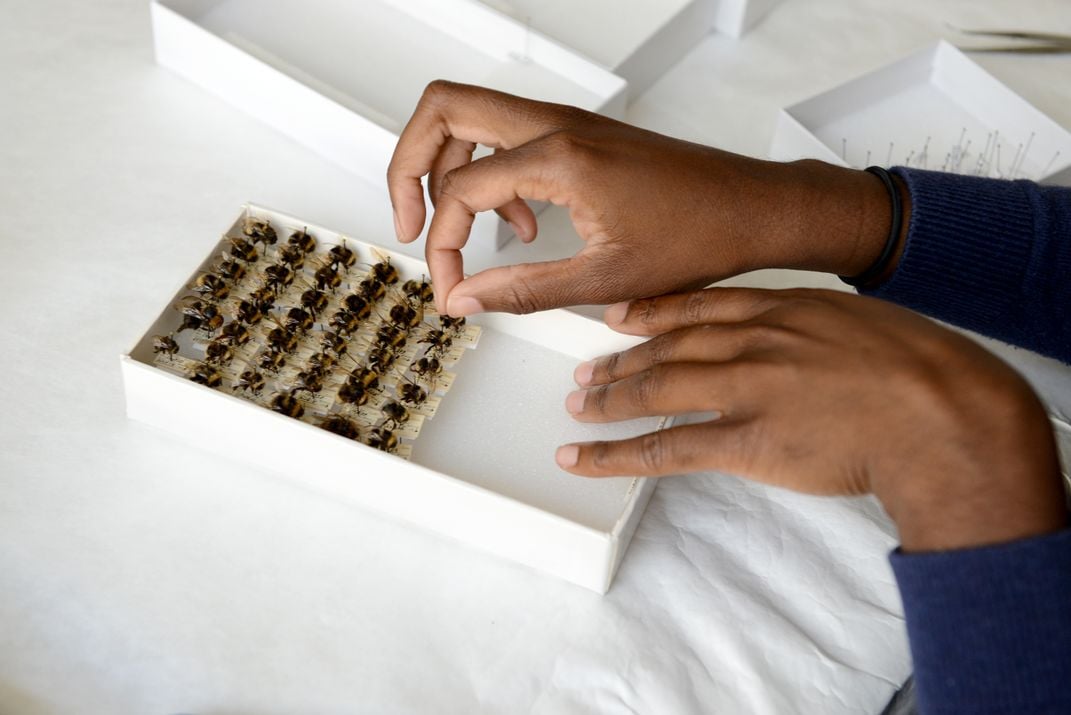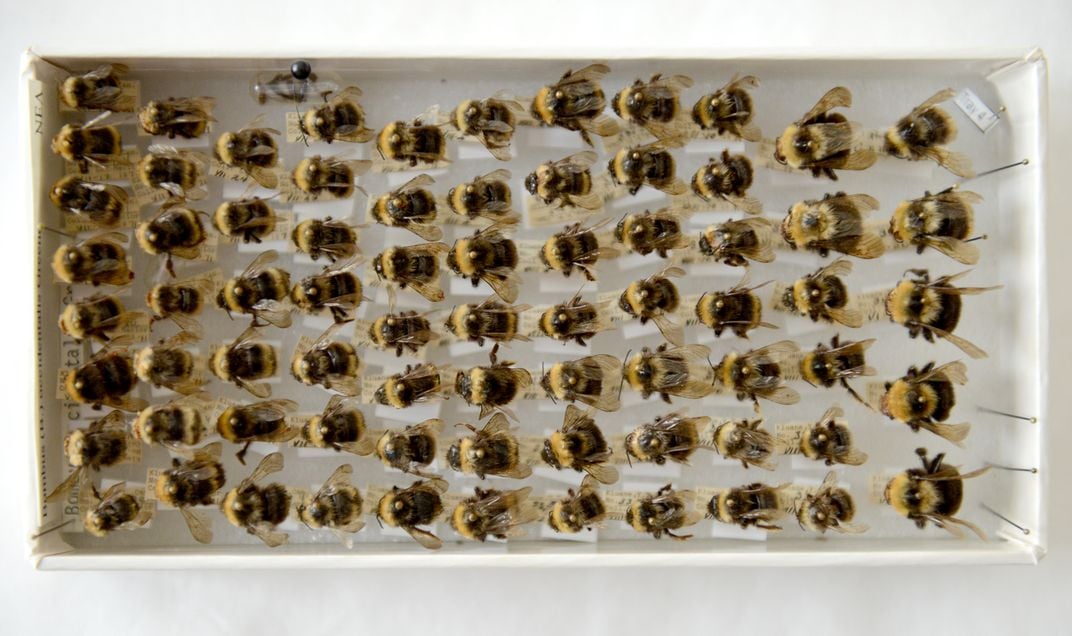Mission Not Impossible: Photographing 45,000 Bumblebees in 40 Days
The Natural History Museum’s entomology department is making its bumblebee collection go viral
Remove a bumblebee from the wooden drawer. Pin it to a foam board and tag it with a barcode. Place it under a strobe light. Snap a picture. Upload the photo to the database. Add more information to the photo in the database. Make it available to the whole world.
For the past four weeks, that’s been the routine for the Rapid Capture Pilot Projects team, which is working to digitize various Smithsonian collections. For this project, the team is digitizing the bumblebees from the National Museum of Natural History’s entomology department. The original goal was to digitize only a fraction of the collection, but working at a rate of 700 to 1,300 bees per day, the team has surpassed the goal and now hopes to get through all 45,000 bumblebees in the collections.
Before they’re ready for their close-ups, the bees occupy wooden drawers at the museum and at an off-site location. Some of them are more than 100 years old. A little slip of paper pinned beneath the bee in the drawer identifies where, when and by whom the bee was captured. When the digitization team photographs the bees now, they also photograph those original tags. The team is relying on volunteers to help input that original tag information into the new database.
“You can recreate environments, say which bumblebees, which birds and which butterflies were at McLean, Virginia, in 1935,” says Dave Furth, the entomology department’s collections manager, providing an example.
So far, 77 bumblebees have gone through the entire digitization process and are available online to researchers, bee enthusiasts and the general public. This project furthers the effort to systematically digitize and make the Smithsonian’s entire collections accessible online. Capturing flying objects other than bees—the aircraft at the National Air and Space Museum, for example—could prove more challenging. The bumblebees represent only the second time that three-dimensional objects from the collections have been digitized in this new program run by the Smithsonian's Digitization Program Office. A collection of vases from the Freer and Sackler Galleries were the first to be photodocumented with this new innovative practice.
Of all the Smithsonian collections to be digitize, choosing one with tens of thousands of items might seem like a strange choice. But the entomology department says that now is a crucial time to study bumblebees.
“Pollinators are a big deal now and especially Bombus,” Furth says, referring to the genus for bumblebees. “They’re becoming rarer and rarer. We don’t always know why. By having the data and having images, people can ask a lot of different questions.”
In May, the White House announced the formation of a task force to investigate and help stem the decline in pollinators, a term that also includes honeybees and butterflies. Pesticides and lack of forage lands are likely among the causes of the decline, the government says. Pollinators are essential to the U.S. economy because they help facilitate crop production.
The entomology department hopes its database can help people understand that decline. “The only way to get an accurate measure of that is to see where the bumblebees lived in the past,” says Seán Brady, the entomology department chair and bee curator. “Really the only way to get that historical data is through the Natural History collections.”
Before this project, the data in the collections were on those slips of paper locked away in drawers and available only by appointment. “What the project is going to do is expose all of that information,” Brady says.
“We do have one of the biggest, most historic bumblebee collections in the world,” Brady adds, “so getting these digitized is just going to be a huge benefit for everyone studying these bees.”
/https://tf-cmsv2-smithsonianmag-media.s3.amazonaws.com/accounts/headshot/MAx2.jpg)
/https://tf-cmsv2-smithsonianmag-media.s3.amazonaws.com/filer/92/55/9255ee62-638f-4c5e-8877-6e147290f0c2/1_dsc_1319copy.jpg)
/https://tf-cmsv2-smithsonianmag-media.s3.amazonaws.com/filer/06/7c/067c1298-2efb-4efb-aa16-5bc8c337696d/2_dsc_1276copy.jpg)
/https://tf-cmsv2-smithsonianmag-media.s3.amazonaws.com/filer/74/ef/74efd28b-5a35-4c5c-8a01-f87468df3e7d/3_dsc_1262copy.jpg)
/https://tf-cmsv2-smithsonianmag-media.s3.amazonaws.com/filer/91/1a/911a1583-78f4-4942-be1b-6b881e02a7ca/5_dsc_1354copy.jpg)
/https://tf-cmsv2-smithsonianmag-media.s3.amazonaws.com/filer/9e/50/9e500514-34a0-457c-821c-8c680b4246ae/6_dsc_1254copy.jpg)

/https://tf-cmsv2-smithsonianmag-media.s3.amazonaws.com/filer/4b/de/4bde11a0-061c-4067-9df4-3b18c81d6a8d/7_dsc_1328crop.jpg)
/https://tf-cmsv2-smithsonianmag-media.s3.amazonaws.com/filer/d6/17/d6172511-b4c6-45b7-8c92-e024a0421c64/4_dsc_1259crop.jpg)

/https://tf-cmsv2-smithsonianmag-media.s3.amazonaws.com/filer/8a/66/8a66f70f-1969-4824-a09e-64c8700f2d7f/9_dsc_1363copy.jpg)
/https://tf-cmsv2-smithsonianmag-media.s3.amazonaws.com/accounts/headshot/MAx2.jpg)